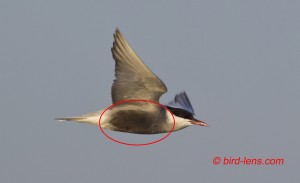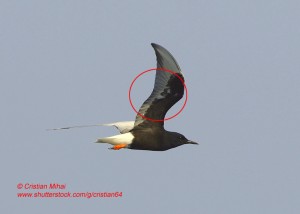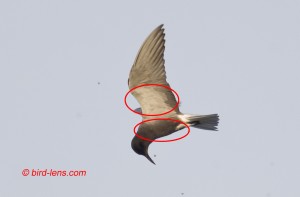Looking at field guides like „ Collins Bird Guide“ from Peter Grant, Dan Zetterstrom, Lars Svenson and Killian Mullarney the ID look quite simple. But even in the breeding plumage Chlidonias – or Marsh – Terns can cause some headache identifying in the field. Then even the Whiskered Tern (Chlidonias hybridus) can be confused with the Black Tern (Chlidonias niger) especially if seen in poor light facing the sun when both terns look remarkably dark.


A remarkable fact is, that the scientific name arises from Whiskered Tern´s similarities in appearance to the Black Tern but also to the (more whitish) Sterna – Terns.
To distinguish Black Tern (Chlidonias niger) and the 3rd member of the genus, the White-winged Tern (Chlidonias leucopterus) is even more sophisticated. The wings do not always look decidedly white – as the name suggests. Often the upper parts of the wings do not look so much brighter than in the Black Tern. On the other hand a good deal of black is shown in the underwing-coverts. Hence the black & white contrast of the underwings might be the best criterion to distinguish flying White-winged Tern from Black Tern in the field.


In flight, all these terns appear slim – less so the Whiskered Tern. The wing-beats are full and dynamic, and flight is often erratic as they descend to the surface for food. Chlidonias – or Marsh – Terns do not dive for fish, but forage on the wing picking up items at or near the water’s surface or catching insects in flight. They mainly eat insects and fish as well as amphibians. The feeding habit is quite unlike the “white” Sterna terns..
Their breeding habitat is freshwater marshes across most of Northern hemisphere (Canada, the United States, Europe and western Asia). They usually nest either on floating material in a marsh or on the ground very close to water.
2 species of Chlidonias – Terns, Black Terns and Whiskered Tern are regularly breeding in the Danube Delta. Mid of May they have just arrived from their wintering grounds The White-winged Tern breed in Romania, too. In smaller numbers and mainly again in the Danube Delta, but not only there. Two years ago, the buachrest birder Cristian Mihai found two pairs breeding 25 kilometers South from Bucharest in the Comana Natural Park. The White-winged Tern is a rather common species during the migration. The picture of the White-winged Tern was taken this year on June 21st in Vadu near Constanta.
The biggest of these terns is the Whiskered Tern. Adult of the Black Tern are 25 cm long and weigh approx. 60 g. White-winged Terns are a little bit smaller. They have short dark (red) legs and quite a short, weak-looking black bill. The bill is shorter as the head (only for the Black Tern it is almost as long as the head), slender, and looks slightly decurved. In non-breeding plumage, most of the black, apart from the cap, is replaced by grey. The ID is even more sophisticated and will be described in a one of the next blogs.
To cope with the growing demand for top shots of the rarer species of the Palearctic Bird-Lens is keen to enrich the range of pictures of birds you can find in the western palearctic. Trips to remote places (Oman´s Desert, Romania´s Macin Mountains) – to capture images of rare birds of western palearctic were very successful. The nice images you find in that blog are only a first impression, what you will find in the gallery in the “Pictures Shop” very soon. Just leave a message, if bird-lens could serve you with an image needed before all new pictures are online.